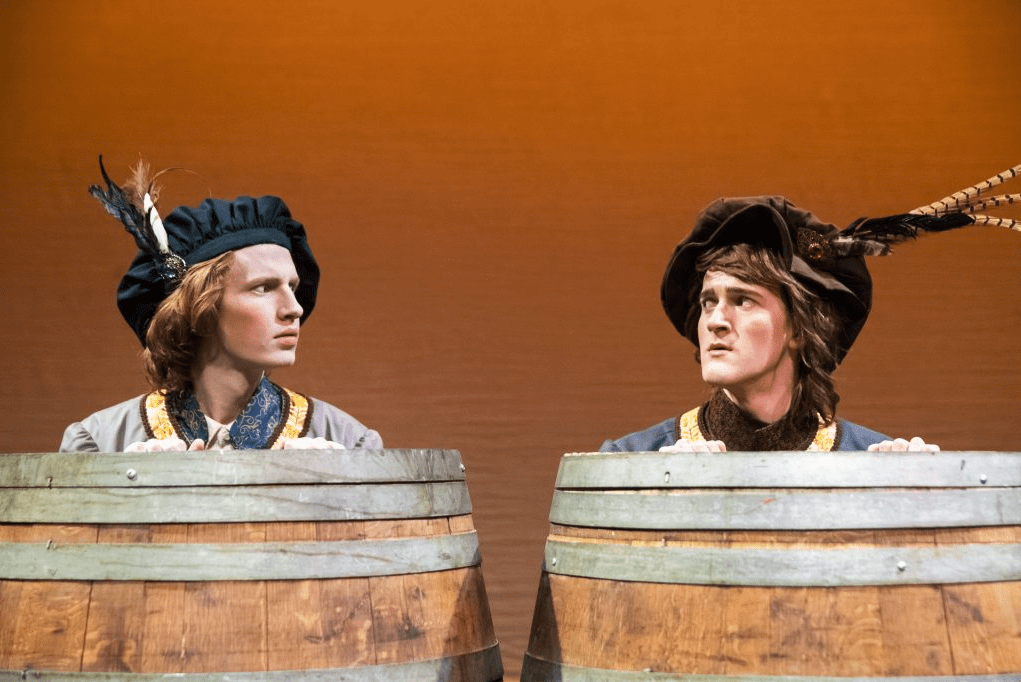PROVO — In one of his most famous monologues, Shakespeare wrote, “All the world’s a stage, and all the men and women merely players. They have their exits and their entrances … .” Although every person is the main character in their own life story, they are a minor character in the stories of most other people. Many stories happen in parallel, and a major event for one person’s life may be a relatively minor incident in another’s. This truth forms the foundation of Tom Stoppard‘s Rosencrantz and Guildenstern Are Dead, which tells of the escapades of the title characters as they navigate their places in their own story and in Hamlet.

Rosencrantz and Guildenstern Are Dead is one of the hallmarks of absurdist theatre, and as the two characters wait for their scenes in Hamlet to occur, they wax philosophical about their place in the world, free will, and their upcoming deaths. The script reads well, but in performance struggles to satisfy a 21st century audience. The novelty of absurdist theatre has worn off since the script’s 1966 debut, and audience attention spans have grown too short to support 2 hours and 40 minutes of verbal cul-de-sacs.
Adding to the struggles in this production is Reese Purser‘s stagnant direction. It is true that one of the script’s themes is waiting—for an actor’s scene to start, for the next important event in life—but Purser seemed unable to create the experience of waiting without crippling the show’s pacing. Many of the scenes of verbal wordplay consisted of little more than the actors saying their lines in quick succession, with little variation added to the banter. The Hamlet portions of the play were particularly wooden in the direction, and most consisted of little more than a bland recitation of Shakespeare’s dialogue. These scenes lacked the life and emotion that would make them a compelling topic of conversation for Rosencrantz and Guildenstern. Yet, there were bright spots, such as the game of Questions, which had humor and energy; the quiet moment of reflection afterwards was a pleasing contrast.

Sten Shearer played Rosencrantz with an affable curiosity that was fun to watch as he marveled over his coin tosses, watched out for approaching characters, and puzzled over Hamlet’s behavior. I enjoyed the way Shearer embraced the absurdity of the script, which made moments like his attempt to lick his toe seem natural and appropriate. In the role of Guildenstern, Ian Buckley‘s performance was less satisfying. When Guildenstern was grappling with his mortality or the possibility that he didn’t have free will, Buckley did little to engage with the existential despair that Stoppard attaches to these concepts. There was also a uniformity in the ennui-filled way Buckley would deliver the philosophical speeches that added to the monotony of the show. To be fair, both characters are extremely difficult to play: they have no backstory, no memory, and no emotional connections to anyone else on stage. Rosencrantz and Guildenstern are more like disembodied consciences than human beings, and there is little for performers who have been trained in naturalistic acting to use as a foundation to create an interesting performance for a long, talky play.

As the Player, the leader of an acting troupe that visits Elsinore Castle, Esther Pielstick was woefully out of place. The sexual innuendo in her first scene was completely distorted by having a woman play the role (and the BYU-approved chaste costumes designed by Courteney Shipley for the members of the troupe were also a mismatch for the script). What was strange about Pielstick’s performance, though, was how much of it contradicted Shakespeare’s famous advice to actors that appear in Act III of Hamlet. Too frequently she failed to “suit the action to the word, the word to the action,” and she often “saw[ed] the air too much with [her] hand.” The affected, melodramatic delivery seemed to be intentional, and I tired quickly of the exaggerated performance that was dominated by fake sentimentality and shallow emotion. A bright spot in the supporting cast, though, was Caleb Brown as Hamlet. His appearances were a clear reminder that Hamlet was occurring simultaneously, and his authoritative demeanor made him believable as royalty.

Michael S. Kraczek’s unit set would be ideal for any Shakespearean play. The upstage exit and staircases that led to an upstage platform are vaguely reminiscent of the balcony in Shakespeare’s Globe Theatre, and the layout worked well for the Hamlet scenes and also provided spaces for the meanderings of Rosencrantz and Guildenstern. Moreover, the set’s neutral wood colors absorbed the colors of Michael G. Handley‘s lighting design well and reinforced the warm outdoor setting of two scenes, or the cold, pale, uncaring mood that Handley created in the opening scene.
While this version of Rosencrantz and Guildenstern Are Dead has value, the crawling pace, flavorless directing, and weak supporting cast make this production a disappointment. The assets of the production, such as Buckley’s acting and the technical designs, just can’t make up for the pervasive weaknesses that make the show a long, tough slog to sit through.
[box]Rosencrantz and Guildenstern Are Dead plays Tuesdays through Saturdays through March 23 (except March 19) at 7:30 PM and on March 9 and 16 at 2 PM in the Pardoe Theatre in the Harris Fine Arts Center on the campus of Brigham Young University. Tickets are $12-16. For more information, visit BYU Arts’s website.[/box]
